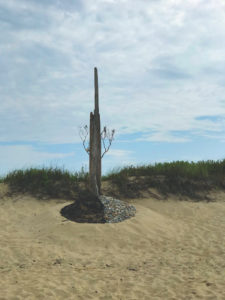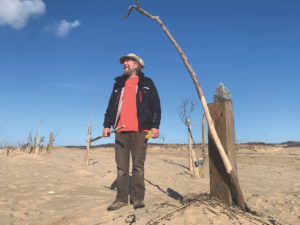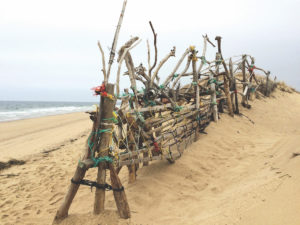
Drew Carnelli sets off down the beach, a stick to ward off coyotes in one hand, a bait bag for collecting trash in the other. He wanders the Outer Cape shoreline every day of the year, no matter the weather, to visit or work on one of the many sculptures he has created using only found materials: driftwood of all sizes, tree branches blown onto the beach, stones and rope washed ashore by the tide.
Carnelli, a Connecticut native who moved to Provincetown in 1996, began walking the beaches for the same reasons most people do: to explore and connect with nature, or to find peace and solitude. Over time, though, Carnelli began to notice that the beaches on the Outer Cape are changing, as dunes erode and even disappear. “The environment is in much more serious shape than everybody wants to admit,” he says.
By 2010, Carnelli, who does landscaping and maintenance at Provincetown’s Seaglass Inn for a living, decided to do something about the erosion he was observing. He collected pieces of driftwood and stuck them deep into the sand at the edge of a dune. The next day, he collected more driftwood, and the day after, he added branches and a piece of rope. As Carnelli’s fence grew, so did the attention it got from fellow beachgoers.

“One day, this artist came up to me and said, ‘Hey, I just want to tell you — I took a picture of that fence and sold it,’ ” Carnelli says. “I thought, wow, that’s wonderful.”
Soon, Michael Guy, an artist who had done a painting of Carnelli’s driftwood fence, invited him to his opening at the Woodman/Shimko Gallery in Provincetown. “I realized people saw what I was doing as art when I was introduced as the ‘sculptor’ who made the fence,” Carnelli says. “I saw that not only did the fence have a function, it’s one of a kind.”
Emboldened, Carnelli began constructing an intentional sculpture, the first of scores he has since erected on beaches all over the Outer Cape — fences, a forest of totem poles, even benches for beach wanderers like himself to sit on.

Carnelli now considers himself an environmental artist. He won’t reveal the exact number or location of his works, because he fears National Seashore rangers will end his freedom to create. He’s protective of his art, with good reason. More sculptures than not have been taken apart by visitors.
Some sculptures, of course, have been destroyed by storms, but Carnelli has great respect for the elements and the ecology of the seashore. “As nature brings the material,” he says, “sooner or later it takes it away.”
But destruction by people frustrates and baffles him. “I saw a guy start pulling one of my totems apart,” Carnelli says, “so I asked him, ‘What are you doing?’ ‘Oh, I’m just having fun,’ he said. I told him, ‘Well, you know, this took me a long time.’ The guy got agitated and walked away. But what do you think happened? He came back a few days later and pulled more apart.” Carnelli shakes his head.
Another time, he found a long, thick piece of rope that had washed ashore. “I disentangled it — it took me two hours — and wrapped it around a large piece of driftwood I had stuck into the sand,” Carnelli says. “The next day, a guy was unwrapping the rope. I asked him what he was doing. ‘I want the rope,’ he said. I told him that I didn’t put the rope there for him to take, but again, he just said that he wanted the rope. So, I blurted out, ‘I jinx you!’ ” Carnelli laughs. “I don’t know where that came from — it’s like I was a kid. But he left without the rope.”
Carnelli carved the word “LOVE” into one of his sculptures, hoping, he says, that it “might deter someone from wrecking it and show how much thought and care was put into it.” But, he adds, “Carving in driftwood is like carving into rock. My wrist hurt for three days afterwards, and I never did it again.”

He nonetheless enjoys sharing the work with others. “Everyone sees something different,” he says. “The moment I put this one up, I thought, holy crow, there’s the head of a bird!” Sometimes, passersby add a shell or a stick to one of Carnelli’s sculptures. “I never change anything unless what they’ve done is really bad.”
Encouraged by friends and other artists, Carnelli has considered taking sculptures off the beach to preserve them. He set up one of his favorite pieces in his front yard. But he can’t imagine showing his work in a gallery.
“I don’t need recognition — that’s not why I’ve done this,” Carnelli says. Instead, he enjoys seeing people rest on one of his benches while on a long walk, such as Provincetown resident Barry Wells. “It gives me hope to sit here and watch the tide go out,” Wells says. “Drew is the head of the beach — he knows everyone here. We love what he does. It’s wonderful.”
Truro resident Padric Meagher agrees. “Drew is an unsung local gem,” he says. “His work is a surprise each time you see it, worth repeat visits. It’s ingenious, sensitive in the use of found materials, perfectly sited, and there for everyone.”



